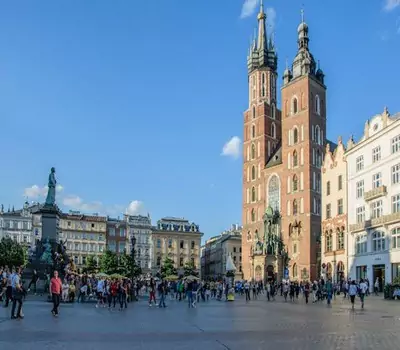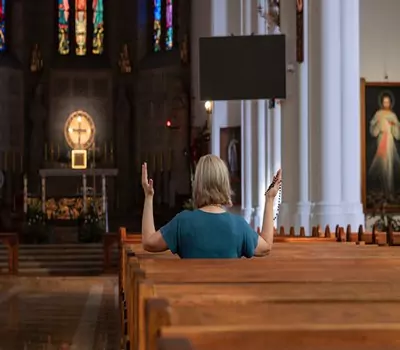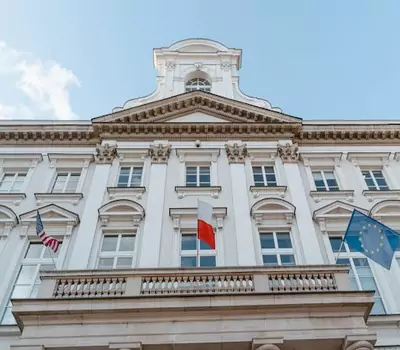Poland might not always be at the top of everyone’s travel list, but once you dive into its rich history, fascinating culture, and natural beauty, it’s hard not to fall in love with this amazing country.
If you’re planning a trip or just curious about this Central European gem, you’re in for a treat! From quirky facts to deep-rooted traditions, here are 23 interesting facts about Poland that most people don’t know—but definitely should.
 1. The World’s Biggest Castle Is in Poland
1. The World’s Biggest Castle Is in Poland
You might be familiar with impressive castles in Europe, but did you know that the largest castle in the world by land area is in Poland?
Malbork Castle, located in the northern part of the country, was built by the Teutonic Knights in the 13th century. This massive brick fortress spans over 143,000 square meters and is a true marvel of medieval architecture.
Today, it serves as both a museum and a historical site where visitors can walk through its halls, admire its Gothic design, and explore its courtyards. The sheer size of Malbork Castle means that you can easily spend an entire day there and still not see everything!
2. Polish: One of the Most Challenging Languages to Learn
Ever tried pronouncing a word in Polish? Chances are, it wasn’t easy! The Polish language is considered one of the most difficult languages for non-native speakers to learn. Its complexity comes from its intricate grammar rules, seven different cases, and a phonetic system filled with sounds that don’t exist in many other languages.
For example, words like “chrząszcz” (meaning beetle) can make even experienced language learners pause. While it’s tough, learning a few Polish phrases, such as “Dzień dobry” (Good day) or “Dziękuję” (Thank you), can go a long way in making your trip more enjoyable. Polish people appreciate the effort!
3. There’s a Desert in Poland
 When you picture Poland, deserts probably don’t come to mind, right? Poland is actually home to the Błędów Desert, a fascinating anomaly located in southern Poland near the town of Olkusz.
When you picture Poland, deserts probably don’t come to mind, right? Poland is actually home to the Błędów Desert, a fascinating anomaly located in southern Poland near the town of Olkusz.
Spanning 32 square kilometres, this desert formed due to extensive deforestation and overgrazing by local livestock over hundreds of years.
While it’s not a natural desert-like those found in Africa or the Middle East, it’s the only desert of its kind in Central Europe.
The area has a dry, sandy landscape with occasional patches of greenery, making it an unusual destination for those who love off-the-beaten-path attractions.
4. Marie Curie Was Polish
Marie Curie, the pioneering physicist and chemist who won two Nobel Prizes, was actually born in Warsaw, Poland. Her full name was Maria Skłodowska-Curie, and she lived in Poland until she moved to France to continue her education—since, at the time, women were not allowed to attend university in Poland.
Her discoveries in radioactivity have made her one of the most celebrated scientists in history. She was the first woman to win a Nobel Prize and the only person to win Nobel Prizes in two different sciences—Physics and Chemistry. Poland takes immense pride in her accomplishments, and you’ll find her legacy honoured across the country, including the Maria Skłodowska-Curie Museum in Warsaw.
5. Poland Is a Green Paradise
Poland is an unexpectedly green country, with over 30% of its land covered in forests. This makes it a haven for nature lovers. The country is home to 23 national parks, many teeming with wildlife.
One of the most famous is the Białowieża Forest, a primaeval forest and UNESCO World Heritage site that straddles the border between Poland and Belarus. It’s one of the last and largest remaining parts of the immense forest that once stretched across Europe.
If you’re lucky, you might even spot the European bison, the continent’s heaviest land animal. For hikers, campers, and outdoor enthusiasts, Poland’s natural beauty offers a perfect escape into the wilderness.
6. Vodka Actually Comes from Poland
 While vodka is often associated with Russia, Poland has a strong claim to the invention of this world-famous spirit. The word “vodka” actually comes from the Polish word “wódka,” which means “little water.”
While vodka is often associated with Russia, Poland has a strong claim to the invention of this world-famous spirit. The word “vodka” actually comes from the Polish word “wódka,” which means “little water.”
Vodka production in Poland dates back to at least the 8th century, and by the Middle Ages, it had become an integral part of Polish culture.
The country produces some of the world’s finest vodkas, ranging from traditional potato-based vodkas to those flavoured with herbs, fruit, or honey.
When in Poland, it’s common to enjoy a shot of vodka (in moderation!) with meals, often accompanied by a hearty toast: “Na zdrowie!” meaning “To your health!”
7. Wieliczka: Poland’s Ancient Salt Mine
Beneath the surface of southern Poland lies the Wieliczka Salt Mine, a marvel of both nature and human ingenuity. This ancient mine, which has been operational for over 700 years, is not just a place to extract salt.
It’s an underground wonderland filled with tunnels, chapels, sculptures, and even an entire cathedral—all carved from salt. The salt mine stretches for over 300 kilometres and descends to a depth of 327 meters, with entire chambers intricately sculpted by miners over the centuries.
Visitors can explore this labyrinth of salt wonders on guided tours, where you’ll be amazed by the beauty and creativity on display underground.
8. Poland Wrote the World’s Second Constitution
Poland is a country with a deep love for freedom and democracy, and that’s reflected in its political history. On May 3, 1791, Poland adopted the first modern constitution in Europe, just a few years after the United States adopted its own. This document introduced progressive reforms to ensure a balance of power and protect citizens’ rights during a tumultuous time in Poland’s history.
Although Poland’s constitution was short-lived due to the subsequent partitions of Poland by neighbouring powers, the date is still celebrated annually as Constitution Day, a national holiday that marks one of the proudest moments in Poland’s democratic history.
9. Warsaw Was Almost Completely Destroyed During WWII
 Warsaw, Poland’s vibrant capital, has a tragic past. During World War II, over 85% of the city was destroyed by Nazi forces, particularly after the Warsaw Uprising in 1944. The Nazis methodically razed much of the city in retaliation for the Polish resistance, and by the end of the war, Warsaw was in ruins. But the city’s incredible resilience shines through today.
Warsaw, Poland’s vibrant capital, has a tragic past. During World War II, over 85% of the city was destroyed by Nazi forces, particularly after the Warsaw Uprising in 1944. The Nazis methodically razed much of the city in retaliation for the Polish resistance, and by the end of the war, Warsaw was in ruins. But the city’s incredible resilience shines through today.
After the war, Warsaw’s Old Town was meticulously rebuilt using photographs, paintings, and detailed architectural drawings. This remarkable effort earned Warsaw’s Old Town a place on the UNESCO World Heritage list, and it now stands as a testament to the strength and determination of the Polish people.
10. Poland Invented the Bagel
The beloved bagel, a staple of many breakfast menus, actually has its origins in Poland. The bajgiel, as it’s known in Polish, was a popular bread among Jewish communities in Poland as early as the 17th century.
These round, boiled-then-baked rolls were often given as gifts to women during childbirth or simply enjoyed as an everyday snack. It wasn’t until Polish Jews immigrated to the United States in the late 19th and early 20th centuries that the bagel became popular in New York City and beyond. So, the next time you bite into a bagel, remember that you’re enjoying a little piece of Polish culinary history!
11. Poland’s Crooked Forest Is a Mystery
In a small, quiet part of western Poland lies one of the country’s most curious natural phenomena: the Crooked Forest (Krzywy Las). This grove of around 400 pine trees, all with a mysterious 90-degree bend at the base of their trunks, has puzzled scientists and locals alike for decades.
Some believe the trees were deliberately shaped by human hands to create curved timber for shipbuilding, while others speculate that it was caused by natural forces. To this day, no one knows for sure why the trees grew in such an unusual way, but the Crooked Forest remains a fascinating destination for those who love a good mystery.
12. Pierogi: Poland’s Famous Comfort Food
 No visit to Poland is complete without indulging in pierogi, the country’s most famous comfort food. These delicious dumplings are typically filled with a variety of ingredients, including potatoes, cheese, meat, mushrooms, or even fruit.
No visit to Poland is complete without indulging in pierogi, the country’s most famous comfort food. These delicious dumplings are typically filled with a variety of ingredients, including potatoes, cheese, meat, mushrooms, or even fruit.
These delicious dumplings can be boiled, fried, or even baked, giving them a unique texture depending on how they’re prepared. They’re often served with a generous dollop of sour cream, melted butter, or caramelized onions, making them even more irresistible.
But what really makes pierogi special is their incredible versatility. There’s a filling for everyone! If you love savoury flavours, you can try the classic potato and cheese (pierogi ruskie), or go for fillings like mushrooms and sauerkraut, minced meat, or even lentils. On the other hand, if you have a sweet tooth, you’ll love fruit-filled pierogi, often stuffed with strawberries, blueberries, or sweetened farmer’s cheese.
13. Poland Is Home to the Heaviest Animal in Europe
The European bison (żubr) is the largest land mammal in Europe, and Poland is one of the few places where you can see these magnificent creatures in the wild. Once nearly extinct due to overhunting, the European bison has made a remarkable comeback thanks to conservation efforts.
The best place to see them is in Białowieża National Park, a UNESCO World Heritage site and one of the last primaeval forests in Europe. The park is home to a thriving population of European bison, along with wolves, lynx, and many other animals. A visit to Białowieża offers a glimpse of Europe’s natural history and a chance to witness these impressive animals in their natural habitat.
14. Poland Has One of the World’s Oldest Restaurants
If you’re a fan of dining in historic settings, you’ll love Poland’s claim to be one of the oldest continuously operating restaurants in the world.
Located in the city of Wrocław, Piwnica Świdnicka has been serving patrons since 1275! This underground eatery started as a brewery for local merchants and later expanded into a restaurant serving hearty Polish dishes like bigos (hunter’s stew), kielbasa (sausage), and żurek (sour rye soup). While it has been renovated over the centuries, Piwnica Świdnicka still retains its medieval charm, making it a must-visit spot for history buffs and food lovers alike.
15. Poland Celebrates Christmas for 12 Days
 Christmas in Poland is a festive and extended affair that lasts for a full 12 days, starting on Christmas Eve (Wigilia) and ending on Epiphany (January 6th).
Christmas in Poland is a festive and extended affair that lasts for a full 12 days, starting on Christmas Eve (Wigilia) and ending on Epiphany (January 6th).
Christmas Eve is the most important day of the celebration, marked by a traditional feast known as Wigilia, where families gather to enjoy a 12-course meal, symbolising the 12 apostles. This meal usually includes fish, beet soup, pierogi, and other meatless dishes.
Before dinner begins, it’s customary to break and share a wafer (opłatek) with each family member, offering good wishes for the year ahead. Christmas in Poland is a time of deep tradition, reflection, and family, filled with carols, religious services, and visits to loved ones.
16. The Legendary Wawel Dragon
Legend has it that Kraków, one of Poland’s most historic cities, was once terrorised by a fearsome dragon. According to local lore, the Wawel Dragon lived in a cave beneath Wawel Hill, where it would feast on livestock and young maidens.
The story goes that a clever shoemaker tricked the dragon by feeding it a sheep stuffed with sulfur, which caused the dragon to drink so much water from the Vistula River that it exploded. Today, you can visit Wawel Castle and see a statue of the dragon at the foot of the hill. The statue even breathes fire every few minutes, delighting tourists and locals alike.
17. Poland Is the World’s Biggest Producer of Amber
Often referred to as the “Gold of the Baltic,” amber has been highly prized for centuries for its beauty and rarity. Poland is the world’s largest producer of amber, particularly from the areas near the Baltic Sea. Polish amber has been used in jewellery, ornaments, and even in ancient times as a form of currency.
The city of Gdańsk, known as the Amber Capital, is home to numerous amber shops and galleries, where artisans create stunning pieces from this fossilized tree resin. Visitors to Gdańsk can even tour the Amber Museum to learn more about the history and significance of this precious material.
18. Kraków’s Market Square Is the Largest Medieval Town Square in Europe
 The Main Market Square in Kraków is not only the heart of the city but also the largest medieval town square in Europe.
The Main Market Square in Kraków is not only the heart of the city but also the largest medieval town square in Europe.
Measuring approximately 40,000 square meters, this vast public space dates back to the 13th century and is surrounded by beautiful historic buildings, including the iconic St. Mary’s Basilica and the Cloth Hall.
The square is a hub of activity, filled with street performers, horse-drawn carriages, and outdoor cafes.
It’s the perfect place to soak up the atmosphere of one of Poland’s most charming cities, especially during the Christmas Market, when the square is transformed into a winter wonderland.
19. Poland Has Over 2,000 Lakes
With its many national parks, forests, and rivers, Poland is a country of natural beauty, and its lakes are no exception. Poland is home to over 2,000 lakes, the most famous of which are located in the Masurian Lake District in the northeastern part of the country.
This region, often referred to as the “Land of a Thousand Lakes,” is a paradise for boaters, kayakers, and nature lovers. The lakes are surrounded by lush forests and charming villages, offering a perfect escape from the hustle and bustle of city life. If you’re looking for tranquillity and outdoor adventure, the Masurian Lake District is a must-visit.
20. Poland Is One of Europe’s Most Religious Countries
 Poland is a deeply religious country, with around 87% of the population identifying as Roman Catholic.
Poland is a deeply religious country, with around 87% of the population identifying as Roman Catholic.
Catholicism plays a significant role in Polish culture and traditions, and many important events in life, from baptisms to weddings and funerals, are marked by religious ceremonies.
One of the most significant religious sites in Poland is the Jasna Góra Monastery in Częstochowa, which houses the famous Black Madonna icon.
Every year, millions of pilgrims from around the world visit the monastery to pray before the Black Madonna, a symbol of Polish faith and resilience.
21. Poland’s Legendary “Polish Hussars” Were Nearly Invincible
In the 16th and 17th centuries, Poland was home to one of the most fearsome military units in history: the Polish Hussars. These elite cavalrymen were known for their distinctive winged armour, which featured large, feathered wings attached to their backs. The wings not only made them look intimidating, but they also created a whistling sound as the hussars charged into battle, striking fear into the hearts of their enemies.
The Polish Hussars played a crucial role in several key victories, including the Battle of Vienna in 1683, where they helped save Europe from the Ottoman Empire. Their bravery and skill earned them a legendary reputation as one of the most formidable fighting forces of the time.
22. Poland Has Europe’s Oldest Tree
Poland is home to the Bartek Oak, one of the oldest trees in Europe. Located near the town of Zagnańsk, this ancient oak is estimated to be around 1,200 years old. The Bartek Oak has witnessed centuries of Polish history and is considered a national treasure.
Standing over 30 meters tall and with a trunk circumference of more than 9 meters, the tree has become a symbol of Poland’s resilience and longevity. Local legends say that King Jan III Sobieski once rested under the tree’s branches on his way back from the Battle of Vienna.
23. Poland Gave the World Famous Composers

Photo by https://www.lubranomusic.com/
Poland has a rich musical heritage, and some of the world’s most renowned composers hail from this country. The most famous is Frédéric Chopin, a 19th-century pianist and composer who is widely regarded as one of the greatest composers of the Romantic era.
Chopin was born in Poland but spent much of his life in France, where he composed most of his famous works. His music, characterised by its emotional depth and technical brilliance, continues to inspire musicians and audiences around the world. Another celebrated Polish composer is Krzysztof Penderecki, known for his avant-garde compositions and contributions to contemporary classical music.
These 23 facts offer a glimpse into the richness and diversity of Polish culture, history, and nature. From its medieval castles to its modern cities, Poland is a country full of surprises waiting to be discovered. If you’re planning to visit or just love learning about new places, Poland has plenty of fascinating stories and traditions to offer.
Essential Travel Information for Visitors in Poland
| Category | Details |
|---|---|
| Currency | Polish Złoty (PLN) |
| Language | Polish (English is commonly spoken in tourist areas) |
| Time Zone | Central European Time (CET, UTC+1) / Central European Summer Time (CEST, UTC+2) |
| Plug Type | Type E (230V, 50Hz) – bring an adapter if needed |
| Public Transport | Buses, trams, metro (in Warsaw), trains – tickets must be validated upon boarding |
| Ride-Hailing Apps | Uber, Bolt, FreeNow |
| Tipping Culture | 10%–15% is common in restaurants, round up for taxis |
| Emergency Number | 112 (EU-wide emergency number) |
| Best Travel Months | May–September (warm weather), December (Christmas markets) |
| Common Scams to Avoid | Overpriced taxis, fake charity collectors, “money exchange” tricks |
| Local Etiquette | A firm handshake is common; punctuality is valued |
| Must-Try Foods | Pierogi, bigos, kielbasa, zapiekanka, paczki |
| Shopping Hours | Malls open ~10 AM–8 PM; many stores close on Sundays |
| Drinking Water | Tap water is safe to drink in most cities, but bottled water is preferred |
| Weather Tips | Winters can be very cold (-5°C to -20°C), so pack warm clothes |
| Common Phrases | “Dzień dobry” (Good day), “Dziękuję” (Thank you), “Tak” (Yes), “Nie” (No) |
Note: The information provided is for general guidance only and may change over time. Travelers are advised to check official sources and local regulations before their trip.
Frequently Asked Questions
What are the must-visit places in Poland for first-time travelers?
Poland has a mix of historical sites, natural landscapes, and vibrant cities. Must-visit places include Kraków (for its Old Town and Wawel Castle), Warsaw (for its museums and reconstructed Old Town), Gdańsk (a beautiful coastal city with a rich maritime history), Zakopane (for stunning mountain views), and Auschwitz-Birkenau (a historical site of global significance).
When is the best time to visit Poland?
The best time to visit depends on your preferences. Spring (April–June) and Autumn (September–October) offer mild weather and fewer tourists. Summer (July–August) is great for festivals and outdoor activities but can be crowded. Winter (December–February) is perfect for Christmas markets and skiing in the Tatra Mountains.
Do I need a visa to travel to Poland?
It depends on your nationality. Poland is part of the Schengen Area, so travelers from the EU, US, UK, Canada, Australia, and many other countries can visit visa-free for up to 90 days. If you’re from a country that requires a visa, you’ll need to apply at a Polish consulate before traveling.
What are the best ways to get around Poland?
Poland has an efficient transportation system. Trains are great for traveling between major cities, while buses cover smaller towns. In cities, public transport (trams, buses, and metro in Warsaw) is affordable and reliable. Taxis and ride-hailing apps like Bolt and Uber are widely available. Renting a car is ideal for exploring the countryside.
What local foods should I try in Poland?
Polish cuisine is hearty and flavorful. Must-try dishes include pierogi (dumplings with various fillings), bigos (hunter’s stew), żurek (sour rye soup), gołąbki (stuffed cabbage rolls), and oscypek (smoked cheese from the Tatra Mountains). Don’t forget to try pączki (Polish doughnuts) for dessert!
Is English widely spoken in Poland?
English is widely spoken in major cities and tourist areas, especially by younger people and those working in hospitality. However, in smaller towns and rural areas, English proficiency may be limited. It’s helpful to learn a few basic Polish phrases like “Dzień dobry” (Good day) and “Dziękuję” (Thank you).
What cultural etiquette should tourists be aware of in Poland?
Poles value politeness and respect. A firm handshake is common when greeting someone. When visiting churches or religious sites, dress modestly. It’s customary to remove your shoes when entering someone’s home. Also, tipping in restaurants (10-15%) is appreciated but not always expected.
How much does it cost to travel in Poland on a budget?
Poland is an affordable destination compared to Western Europe. Budget travelers can spend around €40–€60 per day, covering accommodation in hostels, local food, and public transport. Mid-range travelers can expect to spend €80–€120 per day, while luxury travelers can spend €150+ per day for premium hotels, fine dining, and private tours.
8. Is Poland safe for tourists?
Yes, Poland is generally a very safe country for tourists. However, as with any destination, it’s important to stay aware of your surroundings. Here are some safety tips:
- Low crime rate: Violent crime is rare, but petty theft (especially pickpocketing in busy areas like public transport and tourist hotspots) can happen.
- Safe public transport: Buses, trams, and trains are reliable and secure, but always keep an eye on your belongings.
- Emergency number: Dial 112 for police, fire, or medical emergencies.
- Respect local laws: Drinking alcohol in public places (except licensed areas) is illegal, and jaywalking can result in fines.
- Weather precautions: Winters can be extremely cold and icy, so dress appropriately and be cautious when walking.
Overall, Poland is welcoming to tourists, and common sense precautions will ensure a safe and enjoyable trip.

 1. The World’s Biggest Castle Is in Poland
1. The World’s Biggest Castle Is in Poland